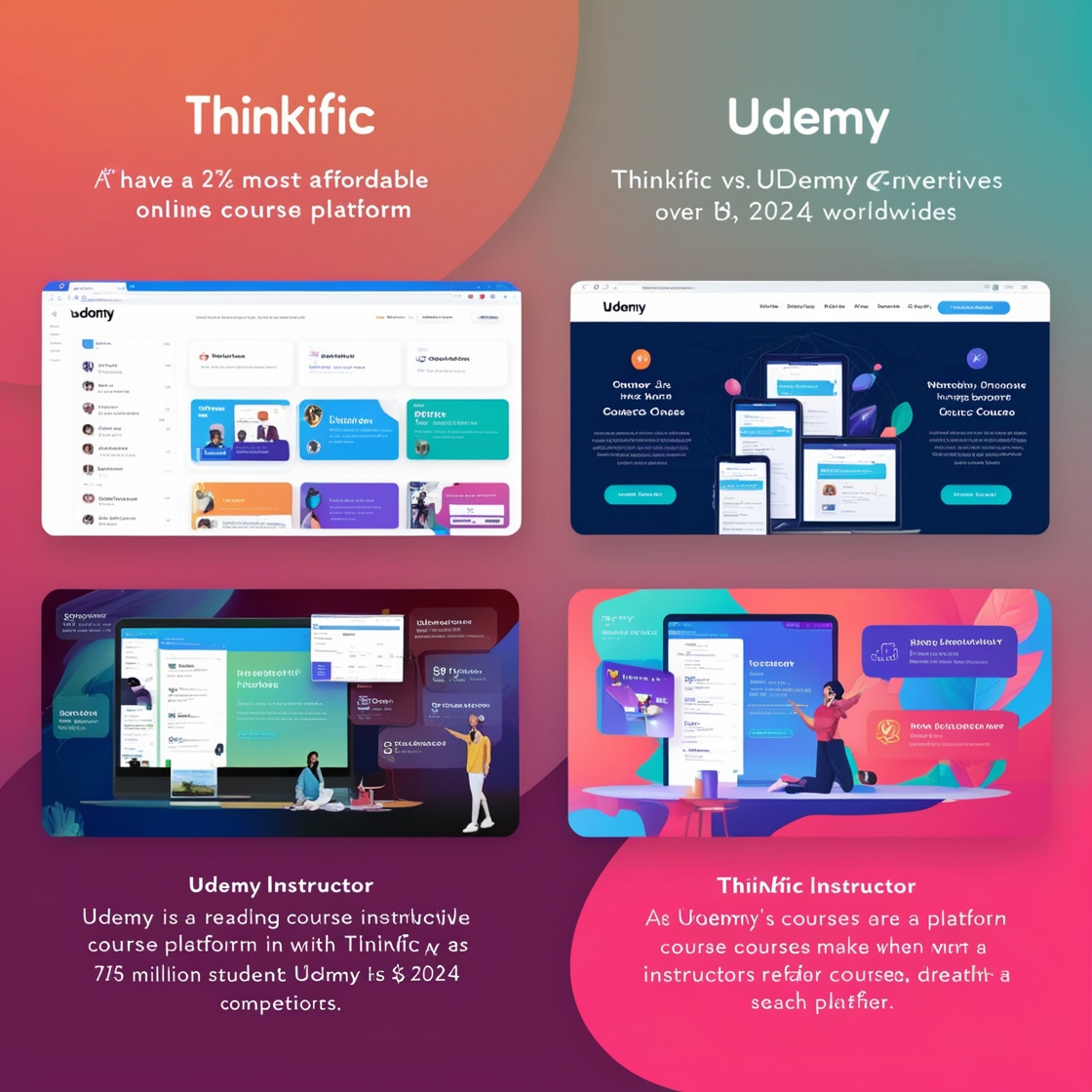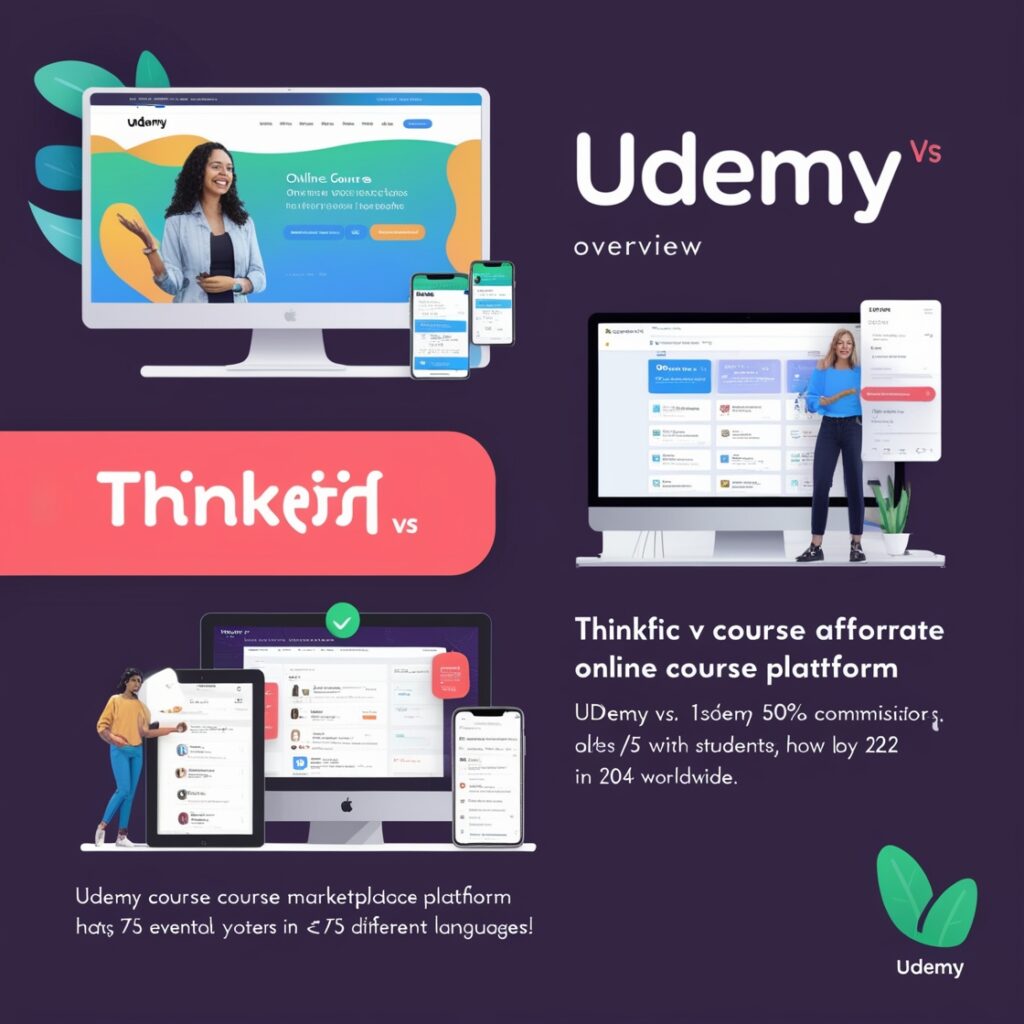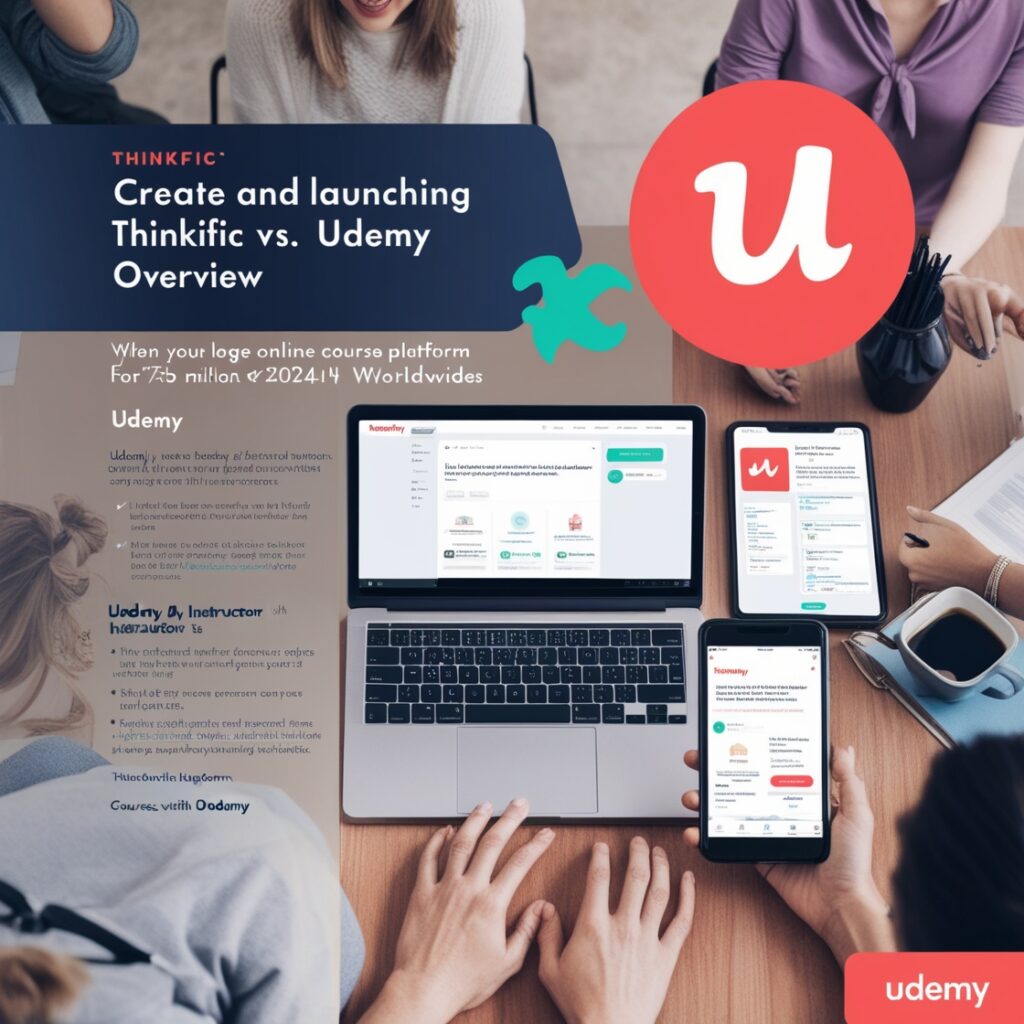Physical Address
304 North Cardinal St.
Dorchester Center, MA 02124
Physical Address
304 North Cardinal St.
Dorchester Center, MA 02124


Creating and launching an online course business can be an advantageous endeavor, but the process of choosing the right platform can be daunting. With numerous options available, how do you decide which one suits your needs best?
In this article, we’ll compare two popular online course platforms—Thinkific and Udemy—to help you make an informed decision.
Udemy is one of the largest online course marketplaces, boasting over 75 million students in 2024 worldwide. Udemy is known for being the 2nd most affordable platform among its competitors.
It has courses in 75 different languages. It offers a wide array of courses across various subjects, making it an attractive option for course creators who want to reach a broad audience quickly.
It comes equipped with a user-friendly course builder, which simplifies the process of creating and uploading course materials. This feature allows instructors to focus on what they do best—teaching—while leaving the technical aspects to the platform.
However, it’s crucial to understand Udemy’s revenue-sharing model. They take a 50% commission on course sales made through their platform when they drive the traffic themselves. This means that instructors only receive half of the revenue for courses sold directly through
Each Udemy instructor is provided with a unique referral code, which can significantly reduce the platform’s commission on sales. When a student purchases a course using the instructor’s referral code, Udemy only charges a 3% commission fee. This system allows instructors to retain a larger portion of the revenue and encourages them to leverage their network and marketing channels to promote their courses.
On the other hand, They also offer an exclusive Marketing Boost service designed to enhance course visibility and reach on the platform. However, this service comes at a cost, with Them charging approximately 70% of the sale amount as an advertising expense.
This trade-off requires careful consideration, as the Marketing Boost can substantially increase course exposure but also significantly reduces the revenue retained by the instructor.
If people come across your course on Udemy’s platform instead through a link you shared you only get to keep 30% of you revenue. Therefore, it’s essential for instructors to evaluate whether the increased visibility and potential sales volume justify the higher commission rate associated with this service.


Thinkific, on the other hand, is an all-in-one platform that allows you to create, market, sell, and deliver your online courses.
Unlike Udemy, Thinkific provides more control over the course creation process and offers features like drip content, quizzes, and a built-in affiliate program.
As of 2024, this platform has more than 100 million students. It has over 36,000 course creators.
One significant difference of using Thinkific is that it does not charge a commission on your course sales, unlike Udemy. This means course creators can set their own pricing and retain 100% of the revenue generated from their sales.
They provide a variety of pricing plans ranging from free to paid subscriptions, offering scalability and flexibility without the impact of high commission rates. This allows instructors to maximize their profit and have greater control over their marketing strategies, aligning better with individual business goals. It offers features like
When deciding between Udemy and Thinkific, it’s crucial to consider what you’re looking to achieve with your online course. Here are some questions to help you determine which platform might be a better fit:
When evaluating between these two platforms understanding their revenue-sharing models is imperative for potential course creators.
When sales are made through an instructor’s unique coupon or referral link on Udemy, the revenue-sharing model shifts significantly in favor of the instructor. In this scenario, the instructor receives a substantial 97% of the revenue from the course sale, leaving only a 3% transaction fee for the platform.
When instructors opt to use the platform’s Marketing Boost service, the revenue dynamics change considerably.
Although this service can help you reach a larger audience base by enhancing its visibility, it comes at a significant cost. In this case, Udemy deducts approximately 70% of the course sale price as an advertising expense. This implies that the instructor retains only 30% of the revenue from sales made through the Marketing Boost initiative.
Thinkific, in contrast, offers a more flexible approach by allowing course creators to retain complete control over their pricing and revenue.
Thinkific does not charge transaction fees directly through its platform, meaning creators can reap 100% of the sales revenue, aside from standard payment processing fees through third-party gateways like Stripe and PayPal. They have an appealing policy where these third-party gateway fees are waived until you reach $1 million in sales within a calendar year.
Thinkific also offers marketing tools such as CTA button or coupon codes you can give other website owners or as a means of affiliate program. They will sell your course usually for a percentage of your revenue.


Ultimately, choosing between the two platforms’ revenue models depends on a creator’s preference for visibility versus control and whether they wish to leverage existing marketplace exposure or independently cultivate their audience.
| Feature | Udemy | Thinkific |
| Revenue Share with Instructor’s Coupon | 97% to Instructor, 3% to the platform | 100% to Instructor (minus payment processing fees) |
| Revenue Share with Marketing Boost | 30% to Instructor, 70% to the platform | Not applicable, no similar feature but full revenue control |
| Fees Charged | Transaction fee for sales; advertising fee for Marketing Boost | Standard payment processing fees (waived up to $1 million in sales per year) |
| Audience Acquisition | Access to their marketplace; requires strategic use of coupons for higher revenue | Self-driven; full control over pricing and marketing strategies |
| Pricing Control | Limited control; prices often influenced by their market promotions | Complete control over course pricing and discount strategies |
This table provides a clear contrast between the revenue share models and related features of Udemy and Thinkific, aiding in decision-making for potential course creators based on their goals of audience reach versus pricing autonomy.
Udemy provides straightforward course creation tools, making it easy to start. The platform guides you through a step-by-step process to upload videos, create quizzes, and add supplemental materials. It provides straightforward course creation tools, making it easy to start.
The platform guides you through a step-by-step process to upload videos, create quizzes, and add supplemental materials.
However, the course creator of this platform is pretty basic in comparison to some competitors, offering limited customization options.
This simplicity can be advantageous for beginners or those who prefer a more structured setup. Still, it may not suffice for instructors seeking more advanced design features and a highly personalized course appearance.
Thinkific offers more robust course creation features, allowing you to build multimedia lessons, drip content over time, and incorporate quizzes and surveys to engage your learners.
This platform also offers customizable course settings, giving you more control over your course structure. With Thinkific, you have the freedom to design your course layout, incorporate a variety of rich media, and adjust the appearance to reflect your personal brand.
Additionally, you can configure the pacing of your course through drip schedules, ensuring that content releases over time to enhance learner engagement.


While both Udemy and Thinkific have their strengths and weaknesses, the decision ultimately comes down to your specific needs and goals as a course creator. Thinkific offers more control over pricing and revenue, while Udemy provides a ready-made marketplace with high visibility but less control over pricing and revenue.
If you value ease of use and instant access to a large audience, Udemy might be the better choice. On the other hand, if you seek control over your course delivery, pricing, and marketing, Thinkific offers the flexibility you need.
Udemy is a marketplace with a large audience and less control over course customization and pricing. Thinkific is an all-in-one platform that offers more control and advanced features but requires you to market your courses independently.
Thinkific is ideal for course creators who want complete control over their courses’ design, pricing, and marketing. Its advanced features like drip content, quizzes, and built-in affiliate programs make it suitable for creating a comprehensive learning experience.
Thinkific pays you directly through your chosen payment gateway, such as Stripe or PayPal. This allows you to receive payments almost instantly, depending on your payment processor’s policies.
By understanding the nuances of each platform, you can select the one that best aligns with your objectives, ultimately setting you up for success in the world of online course creation.